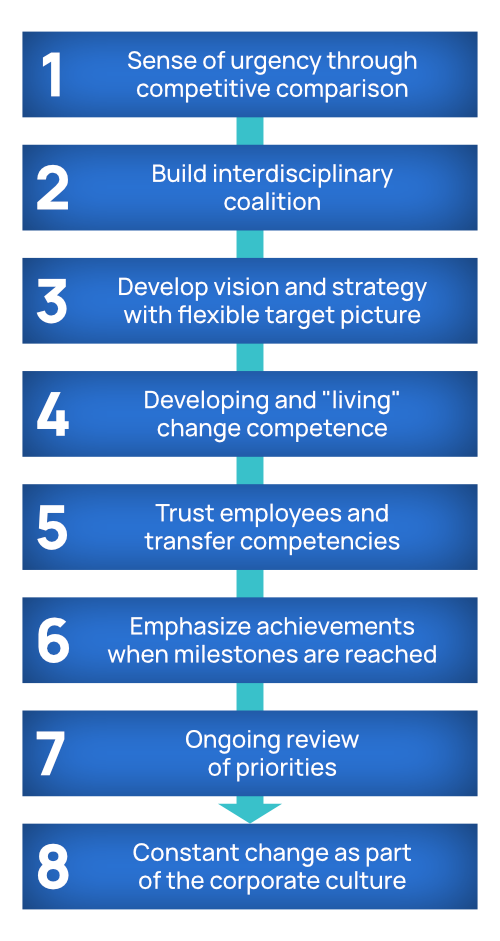In a time that is changing and transforming as rapidly as it is today, the ability of companies to adapt and change is a decisive factor in their economic success. Today, companies simply cannot afford to stand still if they do not want to be overtaken by other companies. Change management has therefore become one of the most important topics for companies in 2022.
Examples of change processes in companies can be the conquest of a new market, the merger or merging of companies, the introduction of new technologies or the saving of resources. Many more examples can be given. In this article, however, we want to explain what change management means in general, independent of a specific situation. We also want to explain for whom it is relevant, who is responsible for an appropriate implementation and why it is necessary at all. In addition, we would like to describe theoretical models and comment on their implementation in practice.
What is Change Management?
The name says it all: Change management is about managing change in a company. This means planning, controlling, monitoring and finally stabilizing it. All the measures, activities and tasks that companies tackle for this purpose are subsumed under this term.
Change management is the discipline of leading individuals, teams, and entire organizations through organizational change and transition to achieve desired outcomes, minimize resistance, and maximize the benefits of the change.
Emily Everhart, Senior Change Manager at Cerner Corporation
However, change management does not refer to every single change in a company. It could be said that every corporate project involves a change, since after its completion something emerges differently, i.e. has changed. However, change management means a profound change that takes place on several levels of the company. It is about the strategies, structures, systems, processes, values as well as behaviors of a company.

For whom is Change Management relevant?
Change management methods are particularly relevant for large corporations, but medium-sized and small companies also need to make an effort. The reason for this is that the factors that require change management affect all companies. Examples of such factors include the following:
- digitalization and technological advances
- the globalization of financial and sales markets
- new demands from employees (for a better work-life balance, home office, etc.)
- political and social changes (new laws, demographic change, etc.)
- ecological changes (scarce resources)
- etc.
The necessity of Change Management
Change projects aimed at adapting to factors such as digitalization are not only advisable for a company. Rather, they are necessary, as the study by Kienbaum & Steptone proves, if the company wants to remain competitive at all. The reason for this need for change management is that change is a constant part of our lives today. Digitalization or globalization, for example, can neither be stopped nor ignored. Therefore, companies today need to be able to react flexibly and adapt to the developments of our world.
Who is responsible for Change Management?
To support change processes, companies often involve external consultants, so-called "change agents", who are exclusively responsible for the change process. They are distinguished by their special training in areas relevant to change management, such as conflict management, project management and communication techniques. Occasionally, entire "change teams" consisting of several change agents are deployed to support and implement change in companies.
In recent years, however, there has been a trend for change management to diffuse more and more into the area of responsibility of executives or managers. The skills and knowledge that used to be attributed to change agents are now increasingly demanded of them as well. As a result, executives themselves are now required to undergo training and coaching in the areas of change management, including conflict management, project management and communication techniques.
There are a number of models that change agents and company managers can use as a guide if they want to manage change processes successfully. They serve as a theoretical guide for practical implementations in companies. The 2 most influential models are briefly explained below.
Influential change management models
There are a number of change management models that change agents and company managers can use as a guide if they want to manage change processes successfully. They serve as a theoretical guide for practical implementations in companies. The two most influential change management models are briefly explained below.
Lewin's 3-phase model
The model which is referred to very often and which is the oldest at the same time, is the 3-phase model of Kurt Lewin. It is the pioneer model of change management and serves as a basis for later developed models. It describes 3 phases that a company goes through when implementing change:
- Unfreezing: First, the realization is made that the status quo is outdated and change is necessary. The goal of this phase is to strengthen and spread this awareness of change throughout the company.
- Moving: The status quo is actively transformed into a target state. Solutions are proposed, behaviors are being tested and, if necessary, the problem is divided into several sub-projects.
- Refreezing: Solutions found are implemented and stabilized. The new target state is in a sense "frozen" and protected from old habits "finding their way back".
Kotter's 8-step model
Another influential model is the 8-step model by John P. Kotter - a much more precise and differentiated model. According to Kotter, all 8 stages must be carried out for successful change management.
- There must be an awareness throughout the organization that change is urgently needed.
- A change coalition, consisting of executives, must form and motivate employees to change.
- A concrete goal and a strategy for change must be developed.
- Both the objective and the strategy are communicated throughout the organization at all levels to gain understanding and acceptance.
- Difficulties, concerns, worries are named and eliminated as quickly as possible.
- The first successes achieved are made visible.
- Changes are driven forward.
- Achieved changes are stabilized and anchored in the company.

Putting theory into practice
The theoretical models of Lewin and Kotter both assume that change processes in companies proceed sequentially, i.e. in a specific order. In reality, however, this is not always the case, which is why the models can be used as an orientation, but need not and cannot necessarily be followed rigidly. Change processes in companies are often very complex and require, for example, a change in the sequence of phases or even the omission of phases.
Also, in practice, the final state reached cannot always be "frozen" for a certain period of time. In fact, our constantly changing world also requires constantly adapting companies. Change management processes therefore often run iteratively, with the achieved target state as the initial state for the subsequent change process. Thus, the different phases "merge" with each other and are not always as clearly separable as in the models set up by Lewin and Kotter.
In practice, particular attention should be paid to the fact that resistance within the company can complicate, if not prevent, the change process.
Avoiding the failure of change process
According to McKinsey, up to 70% of all change management processes, which are tackled. There are certainly many reasons for this frequent failure. However, the main problem is that there is often a lack of concepts for how managers or change agents can deal constructively with the different opinions and ideas of employees about the change process. It has been shown, for example, that affected employees have different views on the goals and means of change or even reject the change altogether. Finding a good way to deal with this as a manager or change manager is a major challenge in the practice of change management.
In practice, successful change management requires a lot of courage, perseverance and confidence. Even if the processes do not always run as smoothly as described in the theoretical models, the efforts are still worthwhile. Change processes promise great new opportunities and are both a possibility and a means for companies to remain competitive and future-proof.

FAQ: What is change management?
What percentage of change projects fail?
According to a 2020 issue of the Harvard Business Review (also cited by FORBES), about 70% of all change initiatives fail.
What are some prominent change management models?
Well-known change management models include Lewin’s 3-Stage Model of Change, Nudge Theory, Mckinsey 7-S Model, the Prosci ADKAR Change Management Model, Kaizen Change Model, Kotter’s Theory, LaMarsh Managed Change Model, Kübler-Ross Change Curve, John M. Fisher’s Change Management Model, Bridge’s Transition Model, Virginia Satir’s Change Model, Rick Maurer’s 3 Level of Resistance and Change Model, Deming Cycle (PDCA).
What is a mindset change?
A mindset change or a mindset shift is when your mind changes from one way of thinking into a different or new way of thinking.







